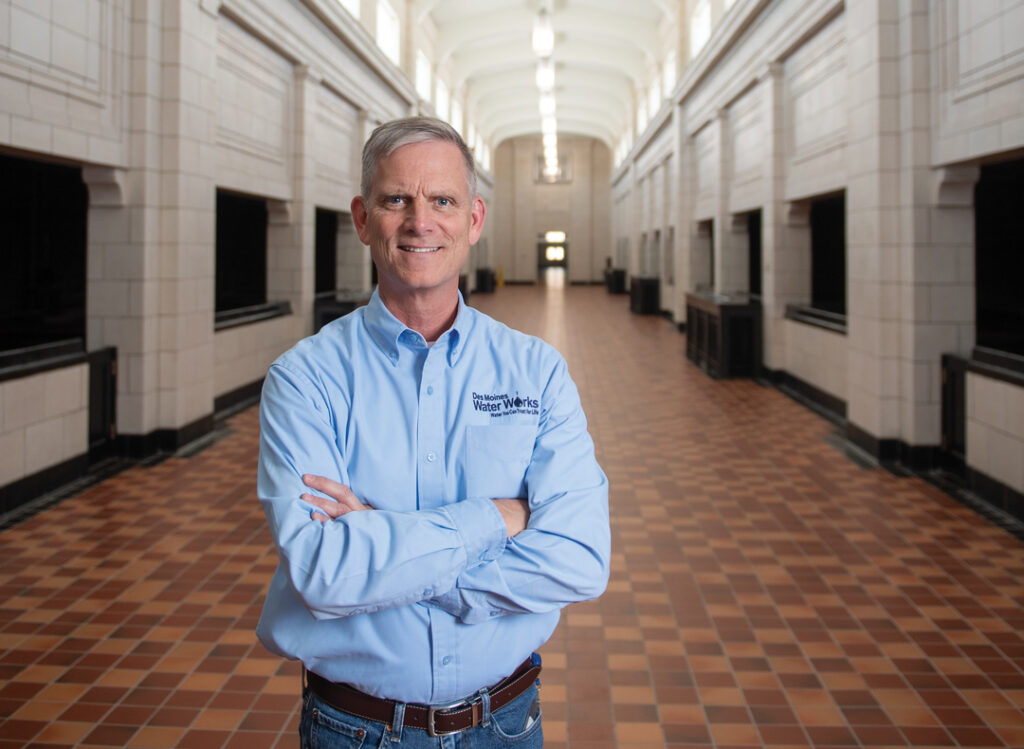Health is built into the community – or not
Public health leader calls for intentionality in planning

JOE GARDYASZ Jul 10, 2015 | 11:00 am
8 min read time
1,996 wordsBusiness Record Insider, Health and WellnessInteresting thing about front porches — many of our homes aren’t designed with them anymore because we’ve moved to our back decks or patios. When front porches went away, so did a lot of beneficial social interaction between neighbors, says Rick Kozin, director for the Polk County Health Department.
“It creates a very different dynamic in terms of the interaction and vibrancy on the street if it’s all in people’s backyards,” he said, “as opposed to how easy it makes it to communicate with people’s neighbors when people are in their front yards.”
Taken to a more macro level, “this notion about multiuse and diverse interaction as part of how we ought be building and designing our communities, I think, is a very critical part of the Tomorrow Plan,” Kozin said.
Greater Des Moines officials, for the most part, understand that all public policy is health policy, he said.
“I think there is a broad level and depth of understanding that health is not off to the side, in clinics or hospital rooms,” he said. “Whether or not we are building healthy communities and whether we are building communities that allow children to be healthy adults is built into how we think the community is going to grow economically, how we think we’re going to be able to educate all of our children. Health is woven into all of those conversations.”
Kozin points to downtown Des Moines’ vibrancy and diverse development as evidence that an intentional approach to building communities can spur tremendous results.
“There are corporate businesses, but there is retail. There are people living here. There will be a grocery store at some point. Being intentional around creating a community that looks like that will create a healthy community, because when things are within walking distance, people will walk. When there is activity on the street, people will be engaged with their neighbors. When people remain isolated in their homes or cars or spend lots of time in front of computer screens, not only are they not being active, that social isolation leads to poor health outcomes.”
City planners and officials must become more intentional about the health impacts of their community design decisions, Kozin said. “Then I think answers and strategies will present themselves.”
“So if we’re designing a street, just don’t end the conversation with ‘Will it move cars better?’ but ask, ‘Will it be easier or harder for people to cross the street or to ride their bicycles?’ ”
A generation ago, Kozin notes, at least two-thirds of schoolchildren walked to school in Des Moines. Now it’s somewhere around 12 to 14 percent. And a majority of parents are driving their kids to school because they’re uncomfortable with having them walk.
“So when we design where we’re going to put schools, we ought to be intentional about whether we’re making it easier or harder for kids to walk to school. If kids were simply walking to school every day, they would be getting the recommended amount of exercise even if they did nothing else.”
The answers are there, if leaders will add more questions to the equation, Kozin says.
“Unless we start asking, ‘What will this do for health outcomes?’, the answers will never present themselves.”
All policy is health policy
An essay by Rick Kozin
There was an outbreak of cholera in London in the 1850s. By itself, this was nothing unusual. However, one local doctor, John Snow, did something very different. He mapped all the cholera cases. He noticed a cluster of cases around the public water pump on Broad Street.
In hindsight what he did next, given what we know now about how cholera is spread, was unremarkable. He removed the handle. And the outbreak came to an end. When Bob Dylan sings, “The pump won’t work cause the vandals took the handle,” this is what he is talking about.
That is not actually true. But what Snow did was groundbreaking because no one had connected the environment to health outcomes. Many people consider this the birth of public health, the origin of epidemiology and certainly the beginning of an intense focus on the environment to improve health outcomes.
For the next 30-plus years we saw this approach produce “sewer and privy construction; improved drinking water quality; quarantine policies; street cleaning; enforcement of safer food, meat and milk product standards; and paved roads.”
As a result, death rates from yellow fever, smallpox and cholera fell as swamps were drained, window glass installed, sewers built and perhaps because nutrition was enhanced.
In addition, the growth of the railroads radically improved people’s diets as fresh crops made their way into urban centers in bulk and at prices most working families could afford.
Nothing on the list fits into what we would now would call medical care, but they were health strategies and they improved health outcomes.
More change was about to come. In 1880 (Louis) Pasteur published his landmark “Germ Theory of Disease,” in which he argued that all contagious diseases were caused by microscopic organisms that damaged the human victim at the cellular level and spread from person to person.
Soon thereafter scientists discovered the bacteria responsible for tuberculosis, cholera and diphtheria. They developed a vaccine against rabies. And they identified the mosquito as responsible for spreading yellow fever.
Among the most progressive public health leaders in America, it was understood that if the identity of each great microbial killer was established, diagnostic tests, vaccines, and cures couldn’t be far behind.
And this began what I would describe as the “medicalization” of health. Better hygiene in medical practice, development and dispensing of vaccinations, antibiotics and other medicines as well as advanced medical technology practiced allowed a dramatic increase in how long people lived.
While our triumph over infectious disease is not complete (as the recent outbreaks of Ebola and measles remind us), all of us feel a greater concern about chronic diseases like asthma, diabetes, hypertension, obesity. The number of people suffering from these diseases is increasing as well as the cost of treating them.
Let’s look at obesity. In 1985 the number of states in the U.S. in which the obesity was greater than 15 percent was zero. In not one state in the country were as many as 15 percent of the population obese. Today, not one state has an obesity rate of less than 20 percent. Think about that. Zero to 50 in one generation.
I would suggest there are two possible explanations for this trend. Either it is an extraordinary coincidence that people across the country, regardless of where they live, their income, their faith, their race or ethnicity, are simultaneously, day after day, making the same unhealthy choices — or there are broader social and political forces shaping those choices.
As a result of these numbers, the steady upward climb of people living longer may be coming to an end. In fact, today’s generation may not live as long as their parents. I’m not sure that has ever happened before. It is an indication that we have reached the limits of the strategy of expecting heath care to produce health.
Let me give you a couple of examples of what I mean by “shaping forces.” If you went out to Gray’s Lake earlier today you would have seen a parking lot full of cars. These are people who walked out their front door, got in their car and drove across town to get out of their car to walk. At the same time of day you would see a line of cars outside probably any elementary school in our community; parents picking up their children so they do not walk home.
This is not about walking. This is about neighborhoods. What both groups have in common is neither one enjoys, feels safe, or is comfortable walking in their own neighborhood. Two different reactions.
The name we give to this framework is the social determinants of health. The research tells us that no more than 5 to 10 percent of what contributes to our health comes from the formal medical/health care system. Another 30 percent can be attributed to the lifestyles and behavior choices people make. But 50 percent comes from the social, political, built and economic environments. Over the last 25 years the numbers attributed to lifestyle/behavior choices and the environments have flipped.
That means housing policy is health policy. Employment policy is health policy. Transportation is health policy. It is not just health policy that is health policy. All policy is health policy. Our current policies were not intended to produce poor health outcomes — but it is an unintended consequence. When we designed a community without sidewalks because it may look more pleasing, no one intended it to discourage walking, but it did. When we designed streets to encourage free-flowing traffic, no one intended to make it more difficult for bikers or pedestrians, but it did. We can, and must, become more intentional.
I want to come back to the challenge of chronic diseases. We are trying to confront them as medical issues alone. We need to recognize them as health issues. Particularly, when we think of being healthy as being able to live your life to the fullest — not just not being sick. And it is not working. We do not have health remedies, per se. There is no vaccine or medication to prevent lead poisoning or asthma. Greater risk reduction opportunities are in the home. Medication alone will not address hypertension, obesity or diabetes, but our community design and our community policies might.
The health issues we are confronting are beyond the capacity of our health care system alone to resolve. It is time for new strategies or a return to old strategies.
Regardless of whether you believe the Affordable Care Act is part of the solution or part of the problem, you recognize our health outcomes are not acceptable and the rising costs are unaffordable. The level of interest and engagement in this conversation creates a unique opportunity to re-examine our strategies of how to create communities, from “human scale design” to urban waterways to affordable housing — as referenced by the previous speakers.
Five years ago the health department convened a planning process called Healthy Polk to identify priorities to create a health community. Included among the final 10 priorities are public transportation, affordable housing and healthy food. People in our community understand all policy is health policy.
It is decision point time. We have two options — boldly tackle the challenges or hold off and hope an asteroid strikes.
One of our challenges is not to get trapped in the “evidence-based” box. We cannot wait for someone to “prove” that a strategy works before trying it. There was no evidence that what Dr. Snow did would work and end the cholera outbreak. It was just a good idea worth trying.
It is also important to not get trapped in the individual responsibility versus environment debate. Obviously we need both. We teach people not to race trains to the crossing. And in the most heavily trafficked areas we install crossing gates. But the threshold in many communities of how many train-car crashes/deaths it takes before individual choices need additional guidance is one.
Prevalence of asthma, diabetes, hypertension and obesity tells us that to continue to depend on individual choices/responsibility alone will not turn the curve. This means we must also be sensitive to the language we use. “The way a problem is defined almost predetermines the kind of solution we will find.” If we think of the issue as obesity, we will continue to focus programs aimed at individuals, as individuals are obese and communities are not. But communities are walkable. Communities are pedestrian-friendly. Communities have safe air and water. People do not.
But the most important key to success is, as a former colleague once said, to be too stupid to not know what won’t work.
Thank you.










